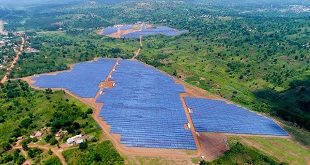
By Julius Businge
Low demand takes toll as local cement prices tumble
This is the best time in two years to buy a bag of cement. Two years ago, a 50-kg bag of cement was retailing at between Shs 30, 000 – Shs 33, 000 at most outlets across the country. Today, the price has dropped to between Shs 25, 500 – Shs 27, 000 – indicating a drop of around Shs 6, 000.
While the trend has been attributed to a glut in supply amidst a slowdown in construction and the real estate industry as well as a decline in exports due to a contracted market, producers can only hope that a fine balance will be struck between supply and demand in the short-term.
“We no longer have scarcity on the market. We can say we have surpassed demand,” Alok R. Kala, the chief marketing officer and Paul Okutui, the sales manager for Tororo Cement Ltd told The Independent on Sept. 23. “We expect the price to remain at the same level in the next three to four years.”
Had it not been for the decline in real estate activity thanks to the prevailing high interest rates that started at the end of 2011, this would be good news to home builders and the construction industry generally. Cement is the main component in the construction sector followed by steel products. Lower prices for the two key commodities would ideally mean more people building more houses and offices.
“Cement carries a 65-75% weight in the construction sector,” says Joel Ssenkungu, a construction engineer at LAT Construction Ltd. “This is a good time to invest in structures that require cement as a raw material.”
Uganda has two major cement manufacturers – Tororo Cement, the largest, and its rival Hima Cement. The two have invested heavily in their production capacity in the last two years – a major factor that has contributed to higher supply without a proportionate increase in demand hence a drop in the price of the commodity. For example, Tororo Cement almost doubled its production capacity in August 2011 to 1. 7 million metric tonnes per annum, from 900, 000 metric tonnes a year before.
Hima, on the other hand, raised theirs from 350, 000 metric tonnes to 850, 000 metric tonnes three years ago. In order for it to increase its current production capacity, Tororo Cement had to invest up to $30 million in their production line in addition to the over $70 million that they invested earlier. This makes it the largest manufacturer of cement in the country, with a 60% market share.
“We are not number one by accident,” boasts Okutui. Indeed, the factory price at Tororo is down to Shs 23, 500 from Shs 25, 500 at the end of 2011. It will be interesting to see if the cement makers will maintain their production level in these circumstances, which definitely means less profitability. But it is surely worrying times for the 1, 000 direct employees and the 7, 000 indirect ones.
Tororo Cement officials said they are committed to continue manufacturing and marketing of building materials – cement and construction steel and galvanized iron sheets though insecurity and political instability in DR Congo and South Sudan have forced the company to cut its exports to less than 20% from 25%.
People in those countries are not buying like they used to do those days, according to Kala, which means the commodity is sold in the Ugandan market only, which over the last two years has been hit hard by high inflationary pressures and a spike in lending rates thus forcing many people to suspend construction projects. This automatically translates into a fall in prices resulting from oversupply.
However, Kala was optimistic that the market would stabilize in the short term. “Things are improving,” he said, adding that the improved economic conditions would favor both the buyer and manufacturer.
Official data from the Uganda Bureau of Statistics (UBOS) indicates that annual changes in the prices of the whole construction sector (covering material prices, wage rates and equipment hire rates) increased by just 3.2% in the year ending June 2013 compared to 7% for the year ending June 2012 – clearly showing that there was a reduction in the general price levels of construction materials in that period.
That means there will be a need for an ‘equilibrium point’ between the supply and demand if the market is to stabilise. A recent geological survey on the cement and steel industry in Uganda carried out by the Ministry of Energy and Minerals showed that as the economy grew there was a spike in infrastructure development to the extent that as of 2010 (before local manufacturers increased production capacity) demand had outstripped supply thus forcing the country to import cement from countries like Kenya, Egypt and Pakistan among others. In 2010 alone, Uganda imported more cement (566,082 metric tonnes) than it exported (390,476 metric tonnes).
However, the survey report showed that cement consumption in Uganda is still low at about 35kgs per capita. Comparatively, South Korea’s per capital consumption stands at 920 Kgs while South Africa’s is at 250 Kgs, according to the International Cement Review – a clear indication that Uganda still has a very long way to go.
However, Ssenkungu, the LAT Construction engineer, is optimistic that this figure would rise. He says the cement industry has “bright prospects” given the demographic growth and urbanization rates in Uganda. In addition, he says the positive economic prospects are likely to see Ugandans improve their GDP per capita, which would translate into more demand for cement as people build more homes.
 The Independent Uganda: You get the Truth we Pay the Price
The Independent Uganda: You get the Truth we Pay the Price


